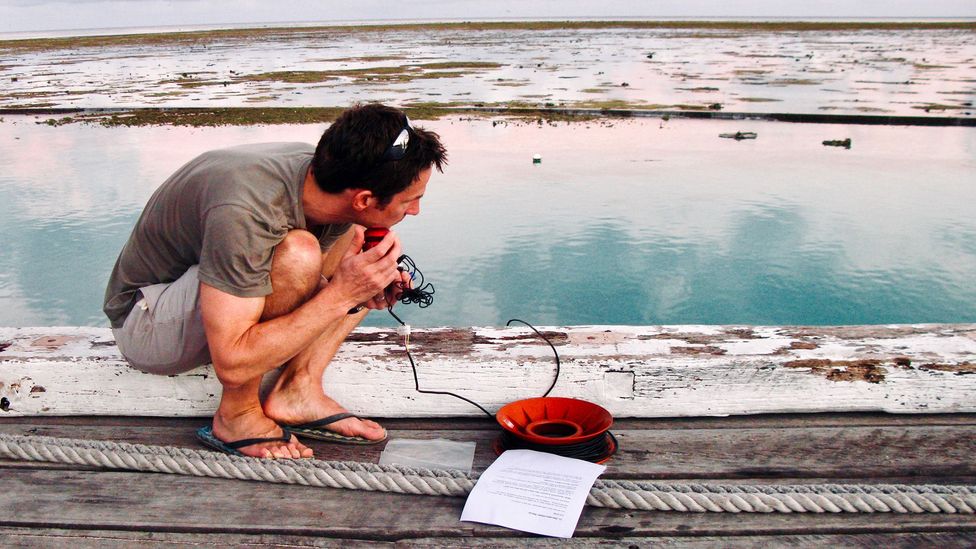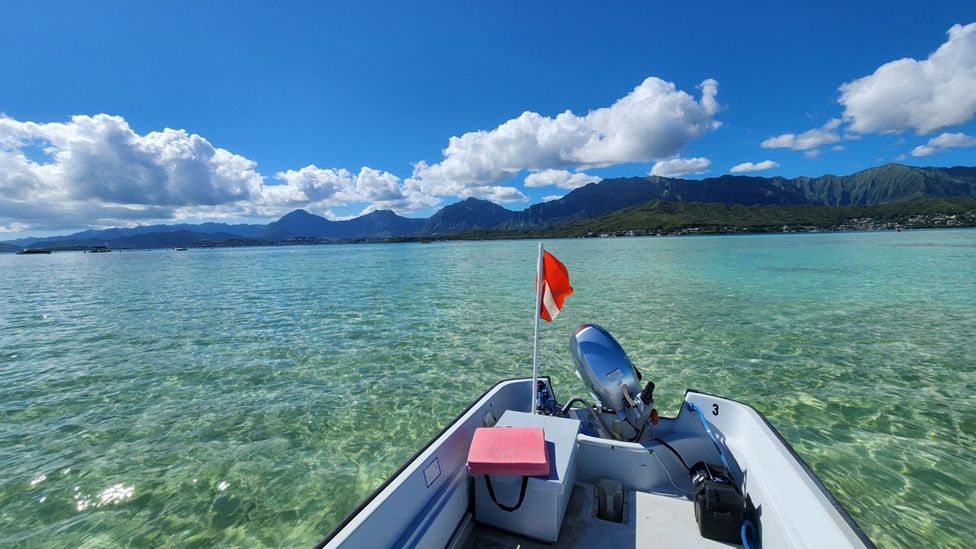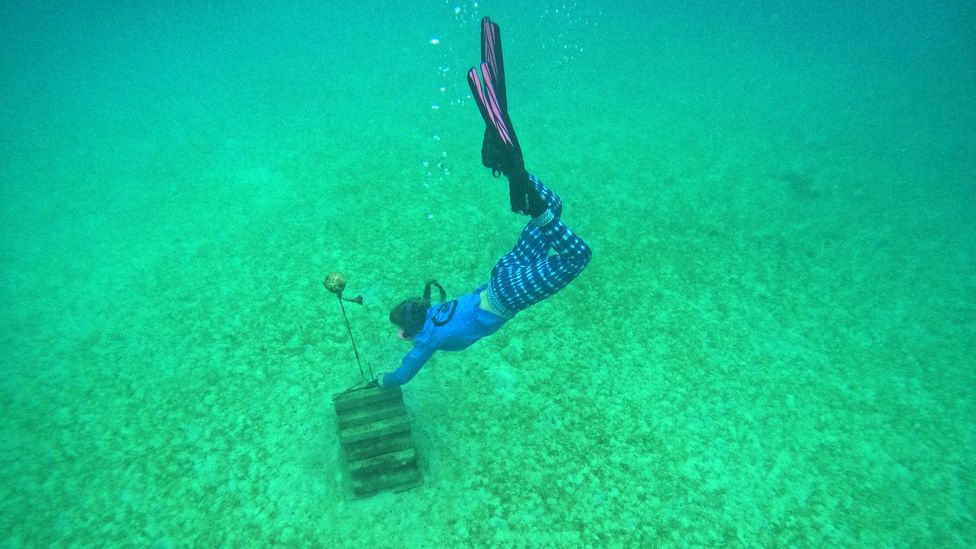Beneath the surface, a ruckus fills the ocean. Clicks, grunts and barks of countless species make up the marine soundscape – a chorus to which humans are often oblivious. Below, you can hear some of these for yourself via sound recordings researchers have made of ocean life.
Sound is essential to many marine animals and one of the main tools they use to survive in the ocean. Light reaches just a few hundred feet below the surface of the water, but sound can travel much farther and faster in water than it does in the air. Some sounds, particularly low-frequency ones like those made by whales, can cover vast distances – travelling for thousands of kilometres, across entire ocean basins.
Scientists believe just 10% of ocean species have been found, with around two million remaining undiscovered
The ocean covers almost two thirds of world's surface and plays a critical role in supporting life on our planet – from the air we breathe and the food we eat, to weather and climate patterns. But there are still huge gaps in our knowledge of ocean life. Scientists believe just 10% of ocean species have been found, with around two million remaining undiscovered.
Even as we uncover new species, however, marine life is being damaged by overfishing, pollution and climate change. A lack of knowledge of ocean life is considered one of the biggest barriers to restoring this marine biodiversity.
In recent years, new technologies – especially artificial intelligence – have allowed researchers to begin listening in to the songs of the ocean in a way they never have before. Recordings of already-known species are helping them to monitor changes in ocean ecosystems due to climate change and other human impacts. Meanwhile, others are as-yet unidentified. New aquatic species are being discovered all the time, providing valuable information on ocean communities – and the biodiversity which is essential for all life on Earth.
In this piece, BBC Future Planet delves into some of the most fascinating recordings from beneath the waves, and allows you to hear them for yourself.
An explosion of sound
Of the almost 250,000 known marine species, scientists think all fully-aquatic marine mammals emit sounds, as well as at least 100 invertebrates and 1,000 fish species.
Fish and invertebrates use sound for basic life functions – take the tiny oyster larvae which use sound to guide them to a healthy reef. Cetaceans (whales, dolphins, and porpoises), meanwhile, have evolved over millions of years to use a variety of complex sounds to help them navigate, communicate with each other and mate.

Researcher Steve Simpson says he has heard reefs both die and recover (Credit: Tim Lamont)
Underwater sound recorders, known as hydrophones, offer researchers a low-cost, non-invasive way to monitor life in the world's murkiest marine environments. Hydrophones can be deployed for days or weeks at a time, giving scientists a real-time look at marine life behaviour, movements and response to environmental changes.
"If we concentrate when we're diving, we can hear animals all around us," says Steve Simpson, a professor of marine biology and global change at the University of Bristol in the UK. "But when we put an underwater microphone into the reef it comes alive, giving us a whole new dimension."
You might also like:
- How to fix our ocean noise problem
- The scientists coaxing back nature with sound
- Seawilding: the Scottish community reviving a loch
To begin with hydrophones were prohibitively expensive, says Simpson, but prices have dropped in the past decade and it's become possible for researchers to have 20 or 30 hydrophones. There are now thousands of underwater recorders in the world's oceans. And, this year, saw a world first collaboration in underwater sound recording.
On 8 June, scientists all around the world took part in a global study of aquatic sound for World Oceans Passive Acoustic Monitoring Day. Researchers compared audio from over 250 sites, creating a snapshot of the global ocean soundscape at one moment in time.
There has also been a "gold rush" of other sensory research in the decades since Simpson first started listening to the ocean, he says, with researchers observing how underwater creatures use everything from smell and magnetism to solar and lunar compasses to navigate their world.
The sounds of the reef
Teeming with life, a healthy coral reef is one of the noisiest places in the ocean. Listening to the presence or absence of noises made by various creatures can give a good indication of whether it is healthy or degraded.
"When we listen to a reef, we hear lots of species at the same time – often animals we can't see," says Simpson. "A soundscape is an acoustic register of species, which is a really powerful way for us to measure biodiversity."
The above healthy reef recording is full of snapping shrimp crackle – a sound that defines healthy reefs and that disappeared when a large portion of the Great Barrier Reef died in 2015–16.
Simpson began researching the lifecycle of coral reef fish 25 years ago. "It turned out there was a lot we didn't know," he says.
For example, adult coral reef fish live on the reefs, but they produce eggs and larvae that develop out in the open ocean. The larvae then return to the coral reef habitats, often the same reefs they started on. "The question was how? What kind of sensory world do they live in that would allow them to choose where and when they wanted to make a reef their home. That's a bit of a big ask of a three-week-old animal," says Simpson.
The break-neck speed artificial intelligence is moving at is removing data-processing as a bottleneck, and enabling researchers to analyse far more samples collected by more hydrophones
Simpson says his team has heard reefs die, but also recover.
"Healthy, vibrant environments start to go quiet, sometimes before you see the change," he says. "You're hearing them dying on the inside. Then you see more obvious bright, colourful animals decline afterwards... Where we are setting up marine protected areas, we hear the communities return. We hear the vibrancy of the reef come back."
Damselfish are also prevalent at most coral reefs – and are used as indicator species for both healthy and degraded reefs. The various sounds heard from different species of damselfish in particular can tell us a lot about the health of an ecosystem.
"The overfishing of mesopredators, like snapper and grouper, causes herbivorous damselfish populations to increase, while some species of herbivorous damselfish will actively kill coral to grow their algae gardens," says Munger. If too many herbivorous damselfish can be heard, scientists can tell the reef is in trouble.
Ocean languages
Scientists have also been able to link the various noises of a single species not only to their presence, but to their specific behaviours.
The recording below is an aggressive territorial display from a dominant female clown fish, defending her anemone on the reef in Moorea, French Polynesia.
"By listening to reefs, we realised we could start to unlock their language," says Simpson. "We've been focusing on clownfish to decode the acoustic language that they use to look after each other, to beat each other up, to attract their mates, to look after their offspring and so on."
Scientists have also learned a lot about the complex behaviours of the damselfish through listening to their sounds, another factor which helps in their use as indicator species.
The sound in the clip below is called a pulse train – associated with the courtship display of the male damselfish.
The sergeant major, a species of damselfish, creates a noise by snapping its pharyngeal teeth together and the resulting sound is resonated by the swim-bladder, says Jill Munger, a marine acoustics analyst at the non-profit Conservation Metrics. This creates pops and clicks which are generally associated with aggressive behaviour and nest defence.
Nesting sergeant majors lay their eggs on open reef and then terrorise anything that comes near with these "booming chirps and aggressive chasing", says Simpson.
Listening to the same habitat over time is also revealing the cyclic behaviour of damselfish. "We realised there are day-night cycles, and dawn and dusk choruses," says Simpson. The fish school together during feeding, then disperse at night to hide from nocturnal predators.
A wealth of ocean data
Hydrophones have been used by scientists to record sounds such as those above for decades, but now artificial intelligence is allowing the analysis of huge amounts of data in a matter of moments.
"We are no longer in a position where we have students sitting with headphones, listening to recordings and noting down what they detect," says Simpson. "With machine learning, we can listen to 10 years of data – or recordings from all over the world from a particular moment in time – simultaneously."
The break-neck speed artificial intelligence is moving at is therefore removing data-processing as a bottleneck and enabling researchers to analyse far more samples collected by more hydrophones, adds Munger. "The more instruments we can get in the water, the more recordings we can collect from a wider variety of places and for longer periods of time too," she say, adding that this is also allowing replication and thus leading to better statistical power of research than ever before.
Researchers are also exploring how AI can be used to livestream and analyse recordings in real time, says Simpson.
We've heard what happens when humans change their behaviour. We've heard what happens when we restore habitats – Steve Simpson
Annie Innes-Gold, a PhD student at the Hawai'i Institute of Marine Biology, collects fish acoustic data from the seas around Hawai'i. She is examining how environmental variables such as temperature changes or nutrient fluctuations might affect vegetation patterns and fish populations.
To do this, Innes-Gold has constructed three artificial reefs made out of cinder blocks in Kāne'ohe Bay, on the windward side of O'ahu. She uses hydrophones – and AI – to listen in on them.
"I'll leave the hydrophones for a month and they record sounds throughout the whole time," she says. "Then I pick them up and offload the data. It's a way to get a lot more information without being physically present."

Annie Innes-Gold collects fish acoustic data from the seas around Hawai'i, where she has heard multiple "mystery fish" she has not been able to identify (Credit: Annie Innes Gold)
Munger from Conservation Metrics analyses Innes-Gold's sounds using AI. Initially, she inputs just a fraction of the sounds as training data. The AI then learns from this what it is listening for and identifies similar sounds from a whole month or more of recordings.
The AI can also calculate a visual representation of sound using spectrograms, says Munger. You can see and hear this in the video below:
Spectrograms show frequency on the (vertical) y-axis, which can be thought of as the pitch of the sound, and time on the (horizontal) x-axis, representing the length of the sound. The energy, or loudness, of sound is represented by the brightness of the colour.
"If we translate the sound into spectrograms, we can then use image classification machine learning models to analyse much larger datasets than if we were to listen manually to all the recordings," Munger says.
The unknown depths
The spectrogram above is of a "mystery fish" – meaning Munger has not been able to identify it. It could be a known species of fish or a one new to science – or it might not be a fish at all. Whatever it is, it's very common at one of Innes-Gold's research sites but not at another site nearby. Many of Innes-Gold's recordings are of mystery species.
"The unknown sounds part of acoustics research is really a difficult problem that everybody's running into," says Munger.
But by sharing information, she says, it's a lot easier to piece together the puzzle.
Innes-Gold's recordings will be part of the Global Library of Underwater Biological Sounds (Glubs), an upcoming open-access online platform designed to collate global information on marine soundscapes. The library will allow researchers to share their data and compare recordings from all over the world.
Another mystery, the trumpeting sound of the "cascading saw" is incredibly prolific at one of Innes-Gold's sites and at a comparison site in Hawaii. It is also incredibly prolific in Palmyra Atoll and possibly in the Red Sea.
"It might be a fish, but we don't know," says Munger. "If it is a fish, it could be a new mechanism of sound production."
Munger identified thousands of examples of the cascading saw sound at Palmyra Atoll.
"What is it and what is it doing at just one site? Was it a spawning aggregation? Are they there year-round? Is it a rare or a common species, a small or big species? This is a discovery waiting to happen."
A noisy competition
Passive acoustic monitoring like the examples above has been shown to be an effective non-invasive technique for sampling aquatic systems – and is particularly useful in deep, dark, turbid and rapidly changing or remote locations.
Carbon Count
The emissions from travel it took to report this story were 0kg CO2. The digital emissions from this story are an estimated 1.2g to 3.6g CO2 per page view. Find out more about how we calculated this figure here.
It is, however, becoming increasingly difficult to hear marine animals under the din of anthropogenic noise (Read more about how we can fix our ocean noise problem)
Still, having witnessed ecosystems coming back from the brink, Simpson is hopeful.
"We've heard what happens when humans change their behaviour. We've heard what happens when we restore habitats. We've heard glimpses of a future which isn't one we need to fear."
--
Join one million Future fans by liking us on Facebook, or follow us on Twitter or Instagram.
If you liked this story, sign up for the weekly bbc.com features newsletter, called "The Essential List" – a handpicked selection of stories from BBC Future, Culture, Worklife, Travel and Reel delivered to your inbox every Friday.
